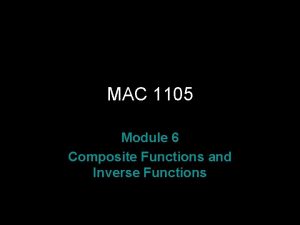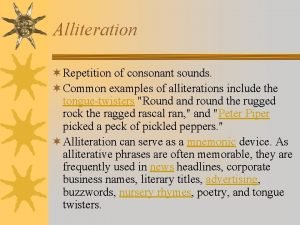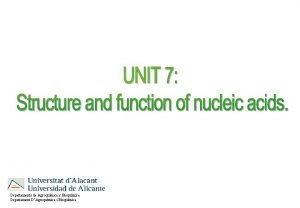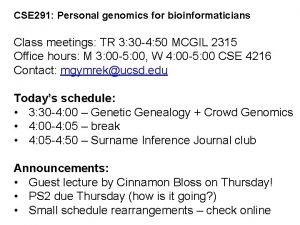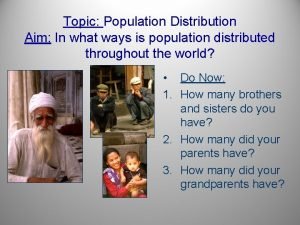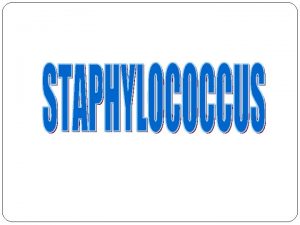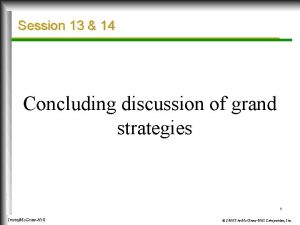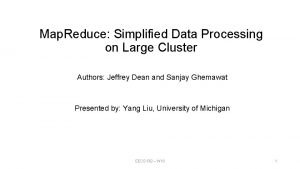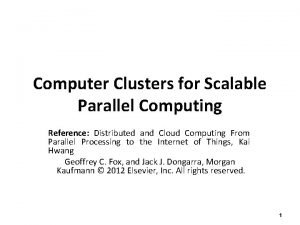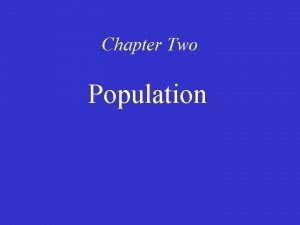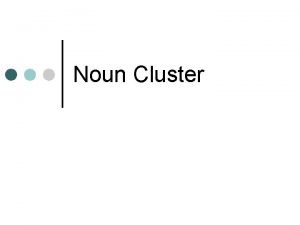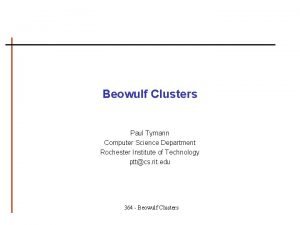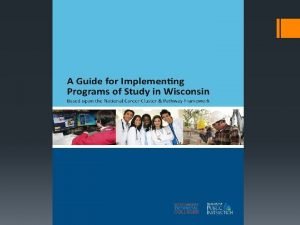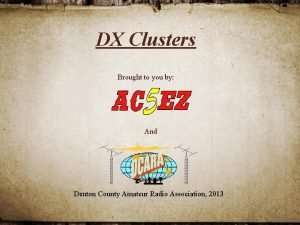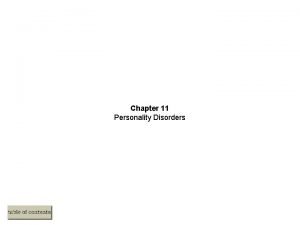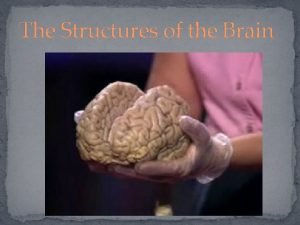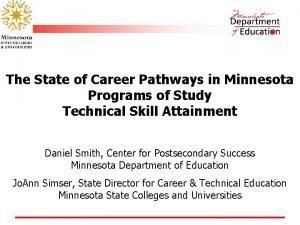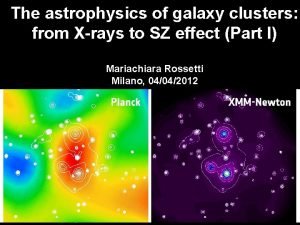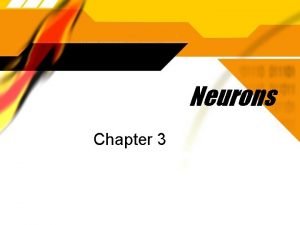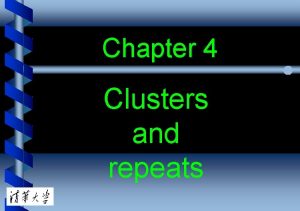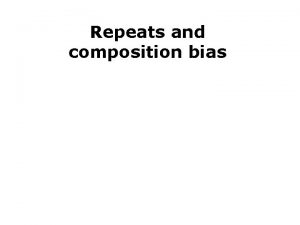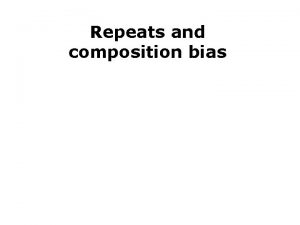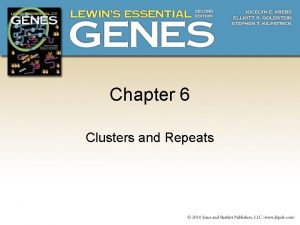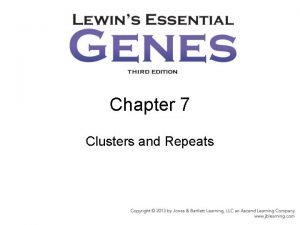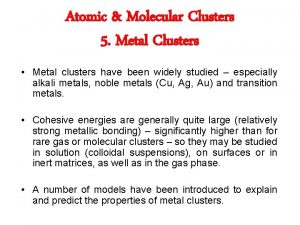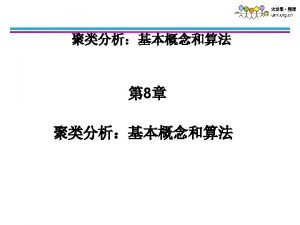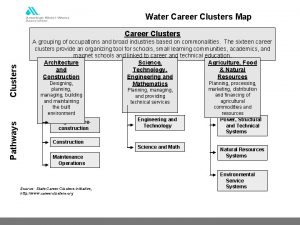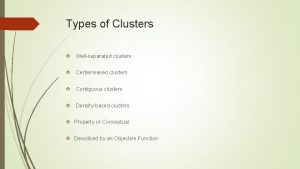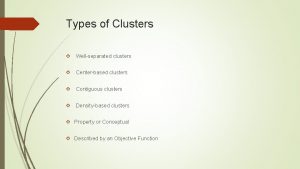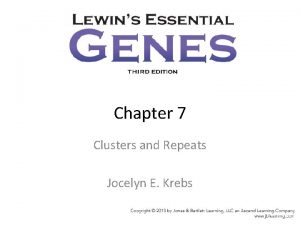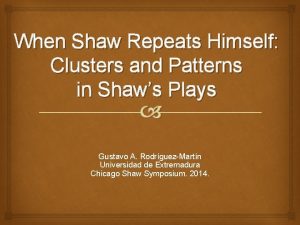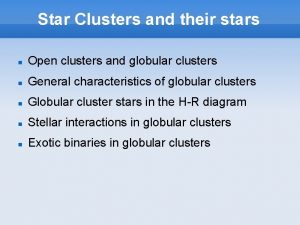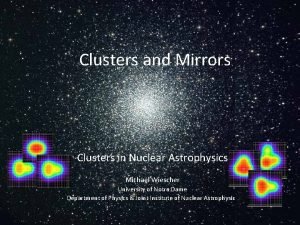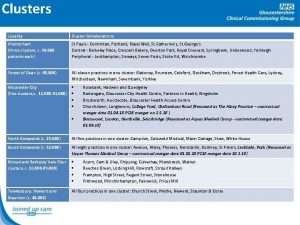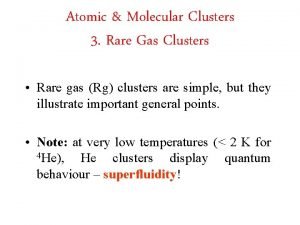Chapter 7 Clusters and Repeats 7 1 Introduction




















































- Slides: 52

Chapter 7 Clusters and Repeats

7. 1 Introduction • gene family – A set of genes within a genome that encode related or identical proteins or RNAs. – The members were derived by duplication of an ancestral gene followed by accumulation of changes in sequence between the copies. – Most often the members are related but not identical.

7. 1 Introduction • pseudogenes – Inactive but stable components of the genome derived by mutation of an ancestral active gene. – Usually they are inactive because of mutations that block transcription or translation or both. • gene cluster – A group of adjacent genes that are identical or related.

7. 1 Introduction Figure 07. 01: Chiasma formation can result in the generation of recombinants.

7. 1 Introduction Figure 07. 02: Recombination involves pairing between complementary strands of the two parental duplex DNAs.

7. 1 Introduction • unequal crossing over (nonreciprocal recombination) – Unequal crossing over results from an error in pairing and crossing over in which nonequivalent sites are involved in a recombination event. – It produces one recombinant with a deletion of material and one with a duplication. Figure 07. 03: Unequal crossing over results from pairing between nonequivalent repeats in regions of DNA consisting of repeating units.

7. 1 Introduction • satellite DNA – DNA that consists of many tandem repeats (identical or related) of a short basic repeating unit.

7. 1 Introduction • minisatellite – DNAs consisting of tandemly repeated copies of a short repeating sequence, with more repeat copies than a microsatellite but fewer than a satellite. – The length of the repeating unit is measured in tens of base pairs. – The number of repeats varies between individual genomes.

7. 2 Unequal Crossing Over Rearranges Gene Clusters • When a genome contains a cluster of genes with related sequences, mispairing between nonallelic loci can cause unequal crossing over. – This produces a deletion in one recombinant chromosome and a corresponding duplication in the other.

7. 2 Unequal Crossing Over Rearranges Gene Clusters Figure 07. 04: Gene number can be changed by unequal crossing over.

7. 2 Unequal Crossing Over Rearranges Gene Clusters • Different thalassemias are caused by various deletions that eliminate α- or β-globin genes. – The severity of the disease depends on the individual deletion. Figure 07. 05: α-thalassemias result from various deletions in the αglobin gene cluster.

7. 2 Unequal Crossing Over Rearranges Gene Clusters Figure 07. 06: Deletions in the ß-globin gene cluster cause several types of thalassemia.

7. 2 Unequal Crossing Over Rearranges Gene Clusters • Hb. H disease – A condition in which there is a disproportionate amount of the abnormal tetramer β 4 relative to the amount of normal hemoglobin (α 2β 2). • hydrops fetalis – A fatal disease resulting from the absence of the hemoglobin α gene.

7. 2 Unequal Crossing Over Rearranges Gene Clusters • Hb Lepore – An unusual globin protein that results from unequal crossing over between the β and δ genes. – The genes become fused together to produce a single β-like chain that consists of the N-terminal sequence of δ joined to the C-terminal sequence of β.

7. 2 Unequal Crossing Over Rearranges Gene Clusters • Hb anti-Lepore – A fusion gene produced by unequal crossing over that has the N-terminal part of β globin and the C-terminal part of δ globin. • Hb Kenya – A fusion gene produced by unequal crossing over between the Aγ- and β-globin genes.


















7. 3 Genes for r. RNA Form Tandem Repeats Including an Invariant Transcription Unit • Ribosomal RNA is encoded by a large number of identical genes that are tandemly repeated to form one or more clusters. • Each r. DNA cluster is organized so that transcription units giving a joint precursor to the major r. RNAs alternate with nontranscribed spacers. • The genes in an r. DNA cluster all have an identical sequence.

7. 3 Genes for r. RNA Form Tandem Repeats Including an Invariant Transcription Unit • The nontranscribed spacers consist of shorter repeating units whose number varies so that the lengths of individual spacers are different. Figure 07. 07: A tandem gene cluster has an alternation of transcription unit and nontranscribed spacer and generates a circular restriction map.

7. 3 Genes for r. RNA Form Tandem Repeats Including an Invariant Transcription Unit • nucleolus – A discrete region of the nucleus where ribosomes are produced. • nucleolar organizer – The region of a chromosome carrying genes encoding r. RNA.

7. 3 Genes for r. RNA Form Tandem Repeats Including an Invariant Transcription Unit • Bam islands – A series of short repeated sequences found in the nontranscribed spacer of Xenopus r. DNA genes. Figure 07. 10: The nontranscribed spacer of X. laevis r. DNA has an internally repetitious structure that is responsible for its variation in length.

7. 4 Crossover Fixation Could Maintain Identical Repeats • Unequal crossing over changes the size of a cluster of tandem repeats. • Individual repeating units can be eliminated or can spread through the cluster. • concerted evolution (coincidental evolution) – The ability of two or more related genes to evolve together as though constituting a single locus.

7. 4 Crossover Fixation Could Maintain Identical Repeats • gene conversion – The alteration of one strand of a heteroduplex DNA to make it complementary with the other strand at any position(s) where there were mispaired bases. • crossover fixation – A possible consequence of unequal crossing over that allows a mutation in one member of a tandem cluster to spread through the whole cluster (or to be eliminated).

7. 4 Crossover Fixation Could Maintain Identical Repeats Figure 07. 11: Unequal recombination allows one particular repeating unit to occupy the entire cluster.

7. 5 Satellite DNAs Often Lie in Heterochromatin • Highly repetitive DNA (or satellite DNA) has a very short repeating sequence and no coding function. • simple sequence DNA – Short repeating units of DNA sequence. • Satellite DNA occurs in large blocks that can have distinct physical properties. Figure 07. 12: Mouse DNA is separated into a main band a satellite band by centrifugation through a density gradient of Cs. Cl.

7. 5 Satellite DNAs Often Lie in Heterochromatin • cryptic satellite – A satellite DNA sequence not identified as such by a separate peak on a density gradient. – It remains present in main-band DNA.

7. 5 Satellite DNAs Often Lie in Heterochromatin • in situ hybridization – Hybridization performed by denaturing the DNA of cells squashed on a microscope slide so that reaction is possible with an added single-stranded RNA or DNA. – The added preparation is radioactively labeled and its hybridization is followed by autoradiography. Figure 07. 13: Cytological hybridization shows that mouse satellite DNA is located at the centromeres. Photo courtesy of Mary Lou Pardue and Joseph G. Gall, Carnegie Institution.

7. 5 Satellite DNAs Often Lie in Heterochromatin • Satellite DNA is often the major constituent of centromeric heterochromatin. • euchromatin – Regions that comprise most of the genome in the interphase nucleus are less tightly coiled than heterochromatin, and contain most of the active or potentially active single-copy genes.

7. 6 Arthropod Satellites Have Very Short Identical Repeats • The repeating units of arthropod satellite DNAs are only a few nucleotides long. – Most of the copies of the sequence are identical. Figure 07. 14: Satellite DNAs of D. virilis are related.

7. 7 Mammalian Satellites Consist of Hierarchical Repeats • Mouse satellite DNA has evolved by duplication and mutation of a short repeating unit to give a basic repeating unit of 234 bp in which the original half-, quarter-, and eighth-repeats can be recognized. Figure 07. 15: The repeating unit of mouse satellite DNA contains two half-repeats, which are aligned to show the identities (in blue).

7. 7 Mammalian Satellites Consist of Hierarchical Repeats Figure 07. 16: The alignment of quarter-repeats identifies homologies between the first and second half of each half-repeat.

7. 7 Mammalian Satellites Consist of Hierarchical Repeats Figure 07. 17: The alignment of eighth-repeats shows that each quarter-repeat consists of an α and a β half.

7. 7 Mammalian Satellites Consist of Hierarchical Repeats Figure 07. 18: The existence of an overall consensus sequence is shown by writing the satellite sequence as a 9 bp repeat.

7. 8 Minisatellites Are Useful for Genetic Mapping • The variation between microsatellites or minisatellites in individual genomes can be used to identify heredity unequivocally by showing that 50% of the bands in an individual are inherited from a particular parent. • variable number tandem repeat (VNTR) – Very short repeated sequences, including microsatellites and minisatellites.

7. 8 Minisatellites Are Useful for Genetic Mapping Figure 07. 20: Alleles may differ by number of repeats at a minisatellite locus, so digestion generates restriction fragments that differ in length.

7. 8 Minisatellites Are Useful for Genetic Mapping • DNA fingerprinting – Analysis of the differences between individuals of restriction fragments that contain short repeated sequences, or by PCR. – The lengths of the repeated regions are unique to every individual, so the presence of a particular subset in any two individuals shows their common inheritance (e. g. , a parent–child relationship).

7. 8 Minisatellites Are Useful for Genetic Mapping Figure 07. 21: Replication slippage occurs when the daughter strand slips back one repeating unit in pairing with the template strand.
 Repeats the beginning consonant sounds in words
Repeats the beginning consonant sounds in words Inverse operations
Inverse operations Repetition of constant sounds
Repetition of constant sounds Monocistronic
Monocistronic State two advantages of cyclical menu
State two advantages of cyclical menu Short tandem repeats
Short tandem repeats Short tandem repeats
Short tandem repeats Iseek career cluster interest survey
Iseek career cluster interest survey Enrichment clusters
Enrichment clusters Jmu cluster 3
Jmu cluster 3 Career clusters framework
Career clusters framework Population distribution
Population distribution Gram positive grape like clusters
Gram positive grape like clusters 15 grand strategies with examples
15 grand strategies with examples Compulsive personality disorder
Compulsive personality disorder Sanjay ghemawat
Sanjay ghemawat High performance computing linux
High performance computing linux Guide to computer forensics and investigations
Guide to computer forensics and investigations If the acceleration lane is short, you will need
If the acceleration lane is short, you will need Vowel clusters examples
Vowel clusters examples Design objectives of computer clusters
Design objectives of computer clusters Four major population clusters
Four major population clusters Career cluster definition
Career cluster definition Danielson clusters
Danielson clusters National career clusters framework
National career clusters framework Hindi transliteration
Hindi transliteration Define career clusters
Define career clusters Noun clusters
Noun clusters Compressional wave parts
Compressional wave parts Types of waves quad clusters answer key
Types of waves quad clusters answer key Virtualization of clusters in cloud computing
Virtualization of clusters in cloud computing Mtcis
Mtcis Career clusters framework
Career clusters framework Rit cs clusters
Rit cs clusters Mcis career cluster inventory
Mcis career cluster inventory Why are career clusters important?
Why are career clusters important? Career cluster wheel
Career cluster wheel Lower brain
Lower brain Highway with short entrance lane
Highway with short entrance lane Georgia career clusters
Georgia career clusters Dx cluster f5len
Dx cluster f5len Maryland career clusters
Maryland career clusters What is sadistic personality disorder
What is sadistic personality disorder Onet career clusters
Onet career clusters Two almond shaped neural clusters
Two almond shaped neural clusters Mn career clusters
Mn career clusters Galaxy clusters
Galaxy clusters Galaxy clusters
Galaxy clusters Two almond shaped neural clusters
Two almond shaped neural clusters Mapreduce simplified data processing on large clusters
Mapreduce simplified data processing on large clusters Types of waves quad clusters
Types of waves quad clusters Rocks clusters
Rocks clusters Galaxy clusters
Galaxy clusters

